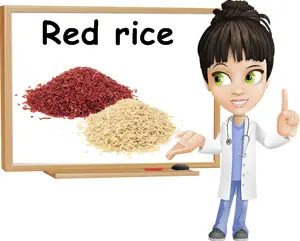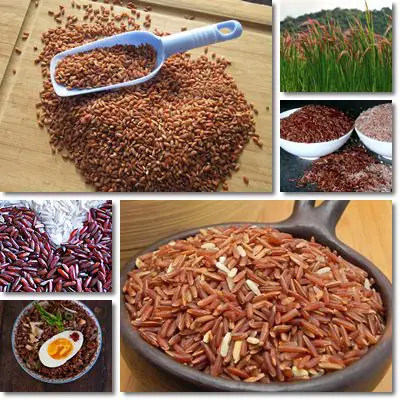Although not so popular as white or brown rice, red rice is a far more nutritious variety than the two. Red rice is a good source of vitamins B1, B2 and B6 and contains moderate amounts of iron and calcium. It is especially recommended for diabetics and heart disease sufferers due to having anti-inflammatory, glucose-regulating, cholesterol-lowering as well as antioxidant properties. According to research, eating red rice has anti-aging effects and may help delay aging signs.
What is red rice and why is it red?
Simply put, red rice is a rice variety that comes in a different color: red, or sometimes a slightly lighter pink-red color. There are in fact several varieties of red rice but, irrespective of where they are cultivated, how sticky the seeds are or whether they are longer or shorter, red rice is full of antioxidant anthocyanin compounds with beneficial effects on human health.

The red pigment in this rice variety is given by anthocyanins, a group of natural antioxidant compounds. Anthocyanins are essentially pigments and are responsible for the red, blue and purple colors of a lot of fruits and vegetables. Some of the healthiest foods are dark-colored and contain anthocyanins. Example: blueberries, aronia berries, blackcurrants, red and black raspberries, eggplants, acay berries and black rice. Both red and black rice owe their impressive medicinal properties to their high anthocyanin antioxidant content.
What does red rice taste like?
Red rice has faint nutty flavors (tastes a bit like hazelnuts to me), but overall quite mild tasting. Some varieties are stickier when cooked.
Red rice vs red yeast rice
While most red rice varieties have a natural red pigment, there is one type of red rice that is obtained with the help of a mold: red yeast rice. Red fermented rice or red yeast rice is obtained by treating normal rice with a mold called Monascus purpureus, which gives rice a dark red (slightly purple) color. Red rice obtained by means of this mold is shown to actively lower cholesterol levels due to the fact that the mold produces monacolin K, a compound with the same action as the medication called Lovastatin. Both Lovastatin and monacolin K reduce cholesterol in a similar manner which is why red yeast rice is also sold as a sort of food supplement or superfood with cholesterol-lowering properties.

Red yeast rice nutrition facts
There is evidence that suggests red yeast rice marketed for medicinal purposes has very little amounts of monacolin K. Although you may purchase the rice, you have no guarantee it is fermented in such a way that it contains the sought-after compound monacolin K or that it has it in sufficient amounts to produce visible health benefits.
Red yeast rice side effects and health risks
It is also possible for red yeast rice to be contaminated with a compound that can cause kidney damage, if the rice is improperly handled. Also, because monacolin K and Lovastatin act in pretty much the same way, reducing the amount of cholesterol our liver produces, they have similar health effects, including the same side effects. So talk to your doctor first if you are planning to include any new foods with active medicinal properties in your diet, more so if you have an existing medical condition.
Signs and symptoms of red yeast rice intoxication include: kidney toxicity, liver toxicity, muscle pain and muscle weakness and birth defects in newborns. Remember to:
- Avoid eating red yeast rice before and during pregnancy or if you are nursing (read more about what foods to avoid in pregnancy).
- Never take red yeast rice supplements in combination with Lovastatin or other similar cholesterol-lowering medication. It is like taking a double dose of the same medicine and the resulting effects could be too strong.
- Red yeast rice can pose serious health risks because it is possible to contain high amounts of monacolin K, in which case it may interact with cholesterol, HIV and depression medication.
Red rice benefits
Regular red rice poses far less health risks and side effects compared to red yeast rice, while boasting rather impressive health benefits:
Benefits for digestion and energy metabolism
Because it contains moderate amounts of fiber and complex carbohydrates, red rice contributes to digestive health, maintaining regularity and combatting constipation, and ensures good energy levels.
Satiating and filling
According to a study published in the British Journal of Nutrition, eating foods which contain complex carbohydrates such as red rice makes you feel full faster. Red rice is said to be more satiating than regular white rice varieties, meaning that you will get the same benefits from eating smaller portions and consequently less calories, with benefits for weight loss whilst enjoying steady energy levels. Another similarly satiating and even more pigmented option is black rice.
Good content of iron and manganese
Red rice is a good source of both iron and manganese. Iron contributes to the formation of red blood cells, helps transport oxygen to muscles and boost energy levels. Manganese is a powerful antioxidant-mineral which prevents free radical damage from building up and causing cell damage possibly resulting in tumors or other diseases.
High vitamin B6 content
Being rich in vitamin B6, red rice helps prevent cardiovascular disease, type 2 diabetes and obesity due to its powerful anti-inflammatory properties and role in carbohydrate synthesis. However, remember that healthy eating means that you can’t rely on just one food. Everything you eat as well as how you choose to prepare your food and combine it dictates the health effects you will enjoy from your diet. See more information on vitamins and minerals.
Benefits for high cholesterol
Red rice consumption is said to lower LDL (bad) cholesterol levels while increasing HDL (good) cholesterol levels. This effect is believed to be owed to both good amounts of dietary fiber and the red antioxidant anthocyanins. Keeping LDL (bad) cholesterol under control is one of the best ways to prevent heart disease.
Other benefits
Last but not least, red rice is rich in antioxidant anthocyanins which promote cardiovascular health and play a role in tumor prevention. Antioxidants are also said to help us look young and fresh by delaying the aging process at cell level. Red yeast rice is a good source of antioxidants as well.
Conclusion
Overall, red rice is a soothing and nutritious food. What makes it so healthy is its generous content of B vitamins, iron and manganese with benefits for the cardiovascular, digestive and nervous system, but also bone health and blood glucose metabolism. However, truth be told, it might be rather scarce or even pricey outside Asia or the US so don’t hesitate to resort to other similarly nutritious, more affordable and readily available foods instead.
